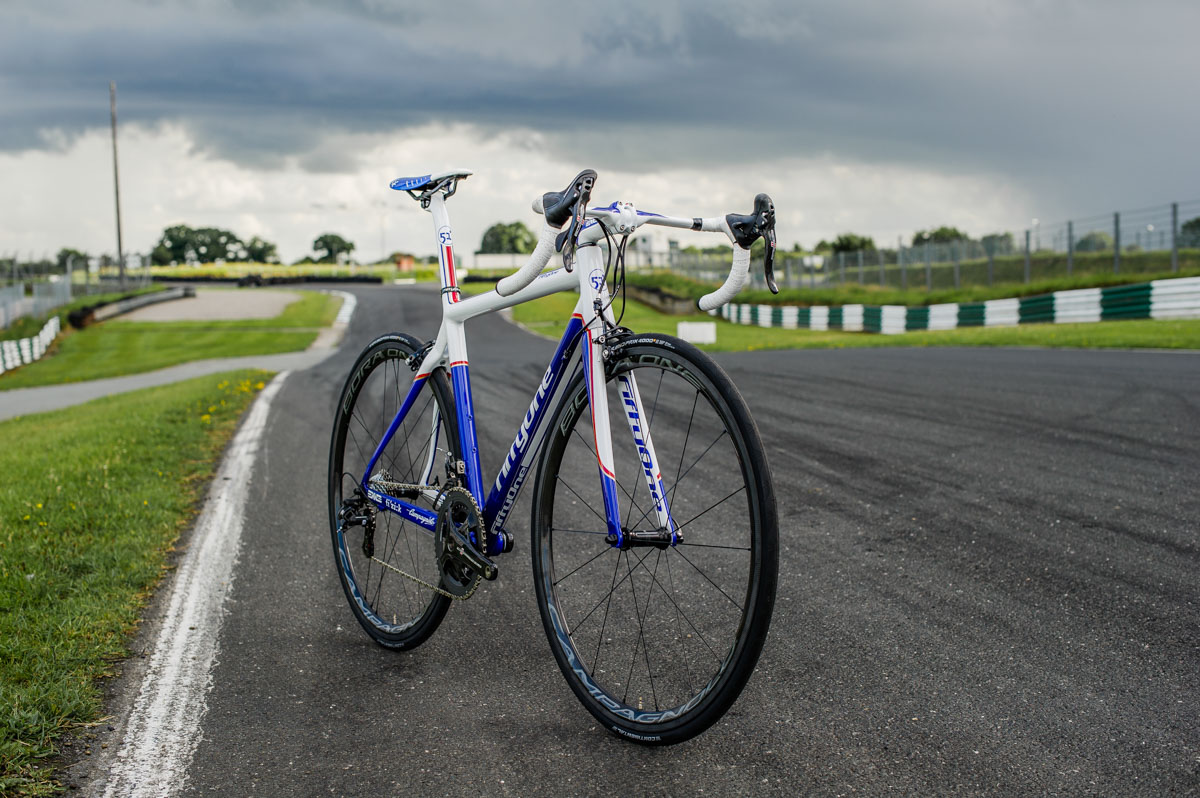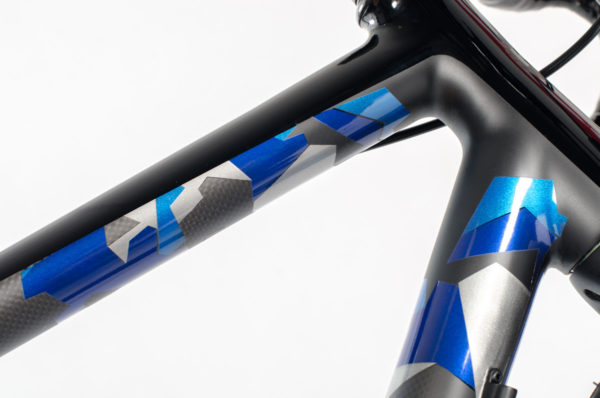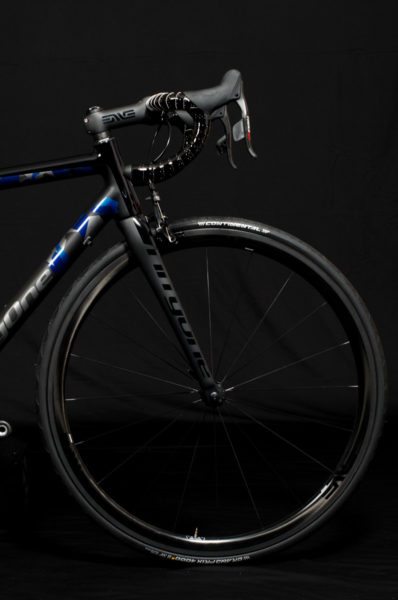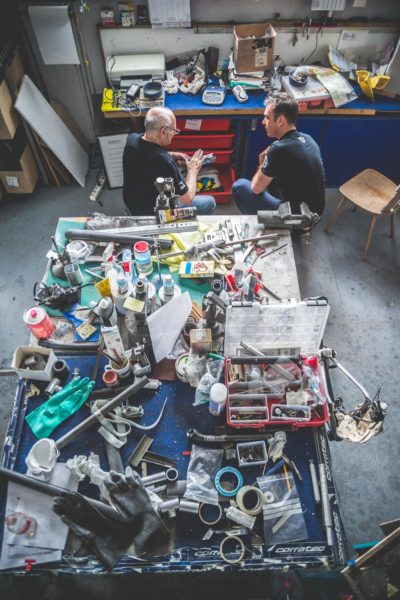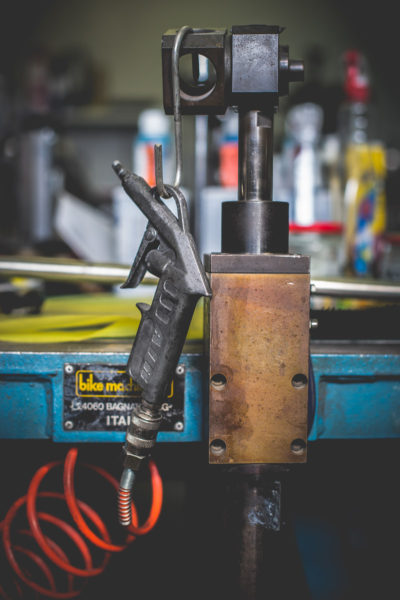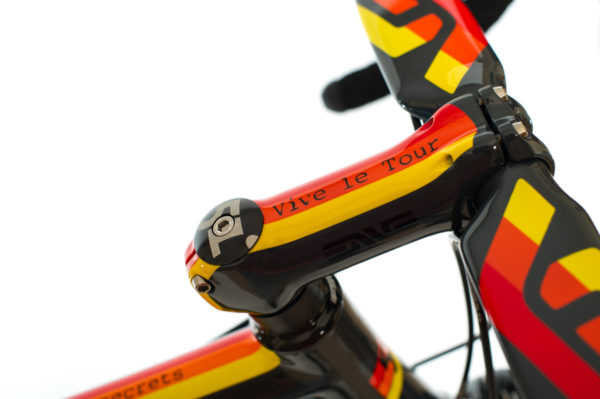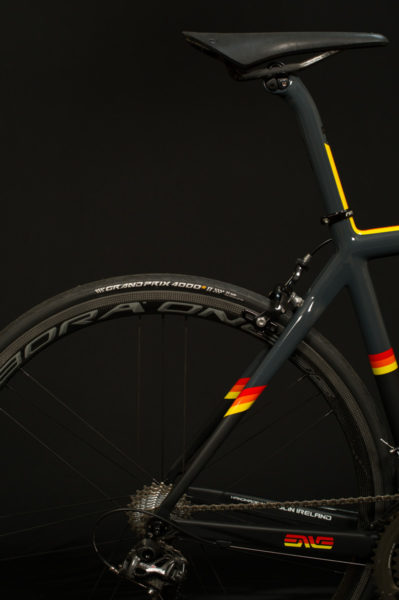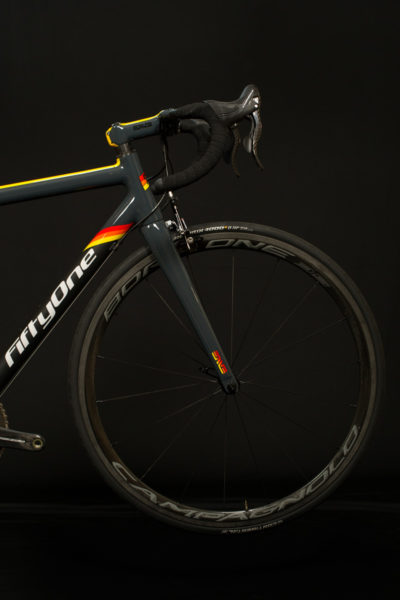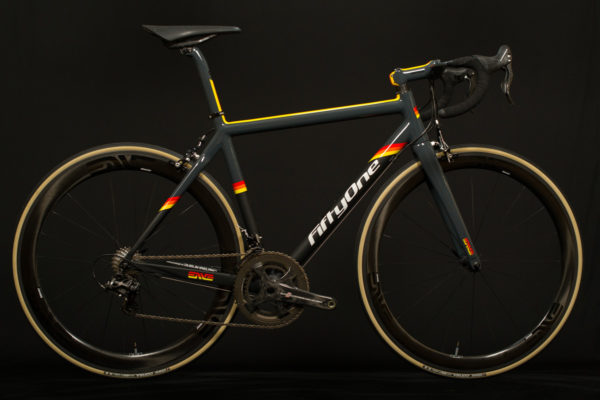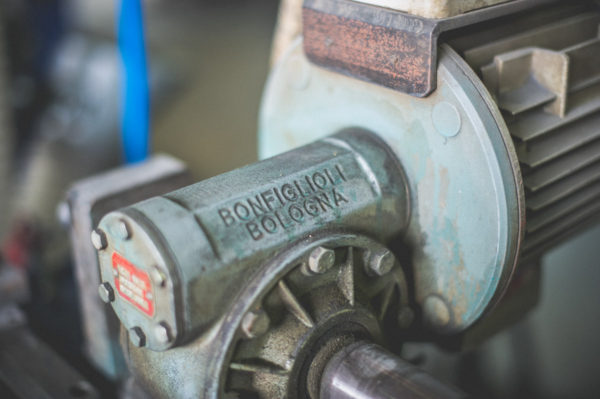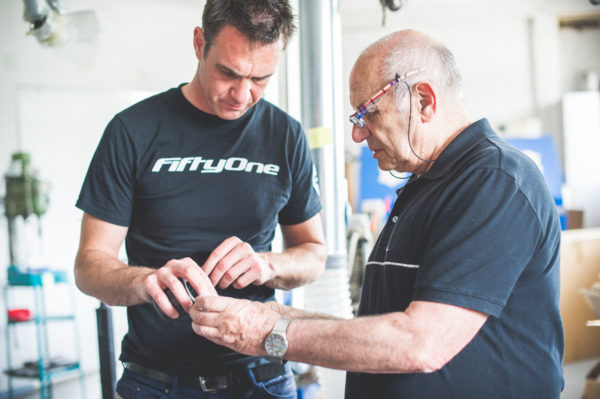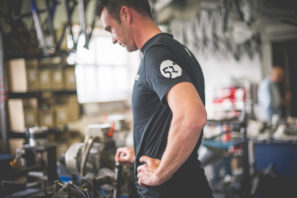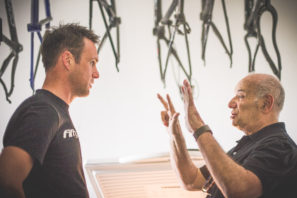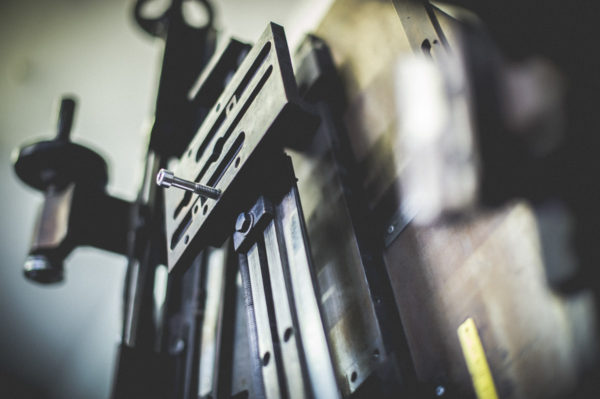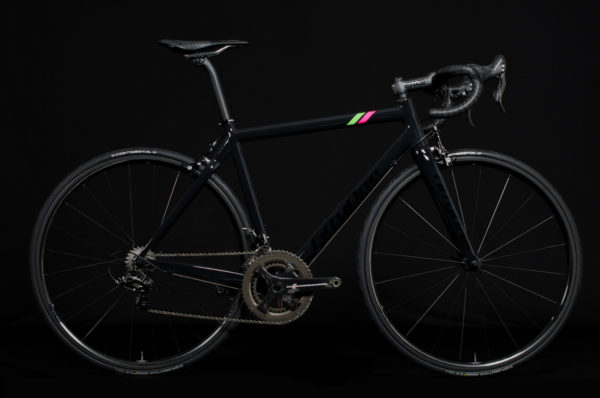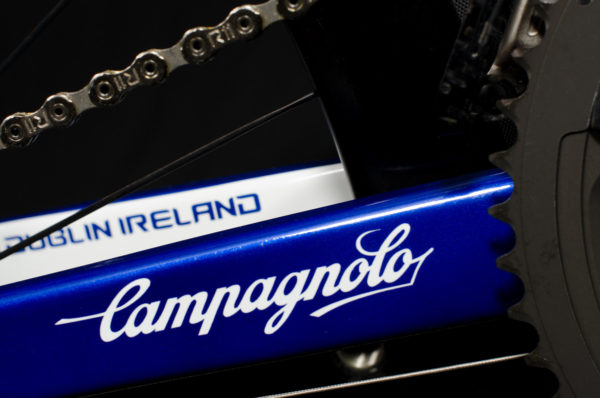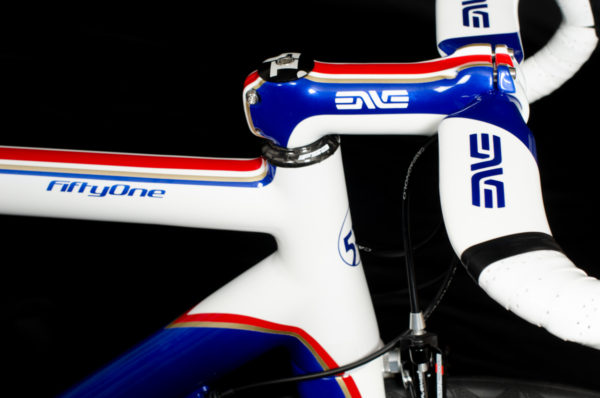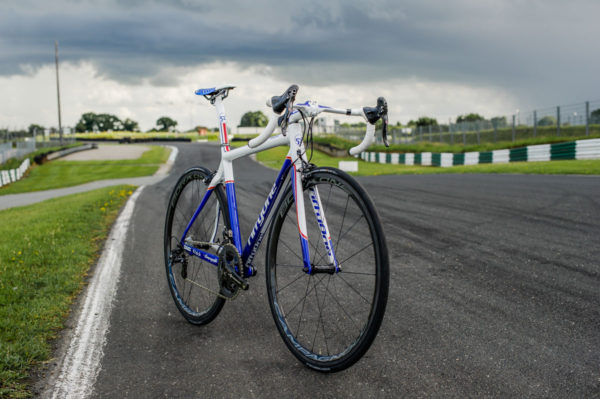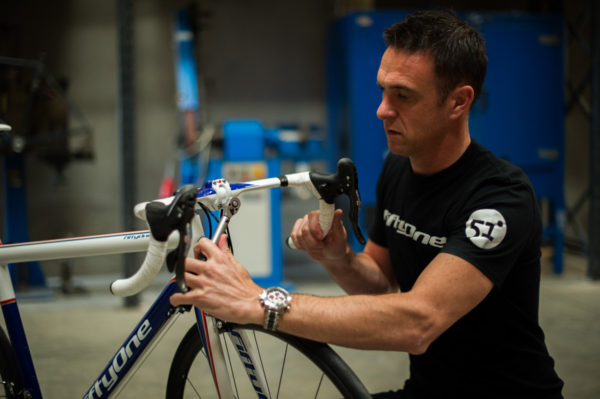Born into an Irish cycling family, Aidan Duff was doomed to a life in bicycles. After leaving a career racing in Europe, he joined the industry and soon found himself dissatisfied with the lack of options and general excitement in product offerings for regular consumers, including the customization he had the pleasure to experience during his racing career. Aidan found himself seeking out options that would elevate the full bicycle experience for riders, from custom geometries to styling and aesthetics.
After a series of serendipitous events culminating in the acquisition and transport of an entire Italian carbon facility from Germany to Ireland, Aidan and his “team of legends” have established FiftyOne Bikes to create what they believe to be the finest bicycle experience possible for the individual customer.
For fans of the genre, it’s just a really good bike story – and the best part is that it is nowhere near over yet.
BIKERUMOR: I guess the interesting place to start is that you were a real deal bike racer, huh?
AIDAN: Yeah, I suppose I was. Yeah, I mean, even just to start out, my grandfather had a bike shop in the 20’s, 30’s, 40’s. I’m kind of third generation involved in the bike business in some way shape or form. When he passed on, my dad rather than try to continue it, he ran a mile from it because I think he’d been forced to work there every spare hour that he had instead of being able to play with his friends. He ran a mile from it, and I got back into it.
I was studying mechanical engineering and I’d been racing with the Irish team. I’d already started doing some international events with them. I obviously really enjoyed engineering at the secondary level, but when I actually started my degree I thought, this is a shitload of math here. This isn’t really for me. I’d rather be making stuff, doing stuff. Then I was offered the chance to go to France. A team basically contacted the cycling federation and invited myself and two others over to France for a season. So I managed to get a year out from my studies and the long and the short of it is that I never went back.
I ended up spending six or seven years in France. I raced at what was referred to as elite 2 level. You tell someone you’ve been paid to race your bike for years, for a lot of civilians, they just say “oh! So you’ve done a Tour de France.” And you have to go “No…”
BIKERUMOR: The assumption here is that you’re racing road.
AIDAN: For sure. For here it would pretty much be road. France is the traditional route for guys in Ireland. The scene, it’s quite rich here but it’s very small. If you really want to develop, you have to go somewhere and typically the Irish and I suppose English speaking in general go to France or even Belgium.
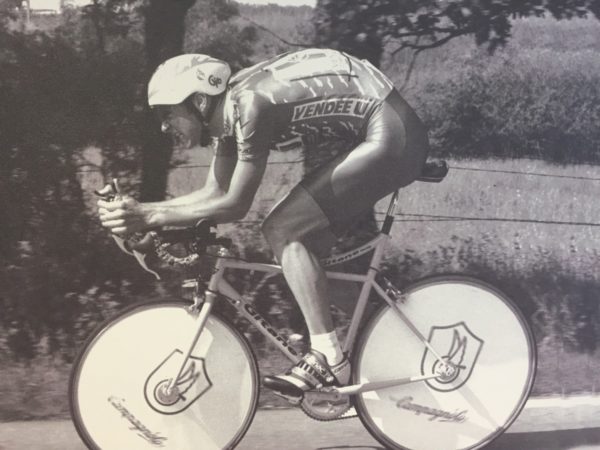
BIKERUMOR: Why is that? Why France?
AIDAN: Well, because here the scene is too small. To put it into perspective, when I was a junior here in Ireland I held every single national title with the exception of one where I finished second – I finished second in the road race and got a bit lazy and stopped training a bit early, but I was National 10 mile champion. I was national 25 mile champion. I was pursuit champion on the track. That’s great, but it’s small. There are only six million people on the island. So if you really want to improve and you want to go all in, you have to go somewhere like France or Belgium. France, what’s the population there? Maybe 67 million? Obviously, cycling, maybe after football, is probably their biggest sport. Whereas here, it was, and probably still is, still a marginalized sport when it comes to competition. It’s totally inversed. You’re like a tadpole in the ocean.
BIKERUMOR: So you weren’t first overall when you zipped across the Channel, then.
AIDAN: I was lucky, they took really good care of us. I was frustrated initially because they didn’t put me in first category racing and I thought, “Jesus, who do these guys think they are?” But it worked out really well because we got to acclimatize and get used to the faster racing speeds and the tactics and things like that. By the end of that season I’d gotten myself up to first category. The following season, I got into the biggest amateur team in France. It started getting serious there on in. The difference was back home, you win 15, 25 races a year. You’re kind of Peter Sagan of the Juniors. And then, all of a sudden in France, IF everything goes well and if everything falls into place, you might win three or four races a year. It’s completely different.
BIKERUMOR: So why we’re talking- you’ve set up a carbon plant in Dublin. It’s an urban area- I would imagine that space is at a premium. So how did that come about?
AIDAN: I hope you’ve got a sandwich because I’m going to try to tell it as concisely as possible. What happened was in terms of cycling I had a road map in my head where I’d put down some pretty aggressive milestones which, you know, that’s kind of the way I roll.
For example, if I wasn’t in kind of a pro tour team by the time I was 22 or 23, well, maybe the sport wasn’t for me. What was the point in kicking around at the slightly lower level for the next ten years. I actually left cycling relatively early and I left it as well because I got kind of close enough to what I thought my goal was to realize that well, actually, this isn’t what I thought it was going to be. It wasn’t exactly the most desirable outcome.
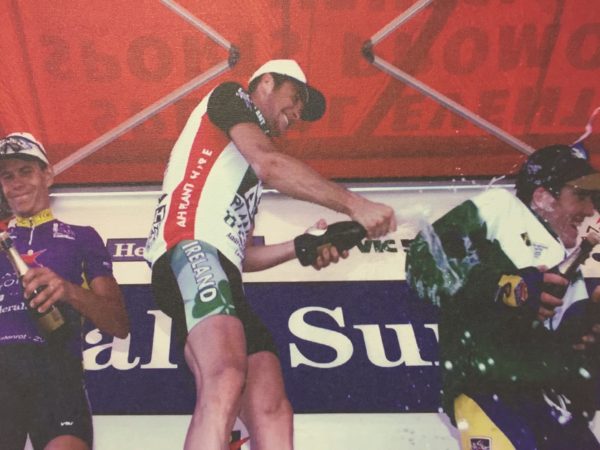
BIKERUMOR: Did you stop having fun?
AIDAN: Two things happened. I realized that I was good on a bike, but that some people were put on this planet to ride a bike. There were way more talented guys than me.
And, I mean, I don’t think fun came into it because you’re at that age where you’re so passionate that you’re obsessive. Fun- I never did it for fun. But I happened to be in France- I was there in ‘95, I was there for the full Festina scandal in ‘98. While I never thought I was naive in terms of medical preparation, I wasn’t ready for the true, full scale, full blown debauchery of the truth as it started to come out. So when you’re kind of in and deep and feel like you’ve sacrificed everything and you hear that out of a squad of 23 riders, 21 riders on the Festina squad were all using EPO. I suppose I naively thought before that that to win the Tour de France maybe you need to do this or need to do that, but when it became apparent that these guys were turning up to do, what we would say, “fish and chipper races” totally, you know…
BIKERUMOR: … jacked?
AIDAN: Yeah. Totally jacked. It’s like, fuck, this isn’t the kind of aspiration that I had.
BIKERUMOR: I have a couple friends who were like, you’re watching it unravel from the inside and it breaks your heart. The curtain comes down.
AIDAN: You’ve just described it really really well to be really honest. At the time I thought, well, fuck, I’ve just wasted five, six years of my life. I could have been doing shit. But I suppose I got deep enough in the trenches to smell the dead bodies- what I realized, Anna, was that once I turned the page and got into civilian life as I was calling it, I quickly realized that what the bike had given me, this mental toughness and this tenacity and this kind of “death or glory” thing that normal people just don’t get. They get tired and they go home or they’ve got a headache.
BIKERUMOR: People don’t appreciate the mental toughness that you have to have at that level- and how much of that success is mental.
AIDAN: Exactly. I suppose what I’m trying to say is that I initially thought that I came away empty-handed but in fact I really consider myself to be very lucky because I got a really (good) insight into the sport, but I also got to kind of walk away on my own terms. I was able to bring those tools that I used in competitive sport and bring them into everyday life. That’s something I’m really grateful for. I also used to do quite a lot with the Irish National Team, so while the activity in France was very serious and formal, the Irish stuff was cool because we would race in Australia and race in Japan and race in Malaysia and all that sort of stuff. I had the best of both worlds. In hindsight, I’m very appreciative of the time I spent on the bike.
So to go back and to actually answer your question in more detail, what happened was, I suppose like a lot of guys, I didn’t really fall too far from the tree. I got a job in a bike shop about straight away. Started off on the shop floor trying to sell some bikes and fix some bikes. I think maybe this mentality shone through, and I started to become involved in the purchasing and the other things. We opened another shop and another shop, and then I moved into the distribution arm of the business. We grew that and grew that. We ended up growing quite a sizeable entity here in Ireland. And then I kind of just wanted to start over and create my own entity from the ground up.
In about 2012 I created my own distribution business. You were referring to being in the business and finding locations- fortunately, that was one of the positives because we had the location already. It’s about 5,000 square feet. So what we had to do to accommodate the production end of the business was to kind of strip some of that out and make some space.
I’m sorry I’m jumping back and forth.
BIKERUMOR: You’re fine. You started this distribution entity, what need for a distribution entity did you see?
AIDAN: I didn’t question that there was a need. It was all I knew how to do. I started to carve out a bit of a niche for US companies. I originally introduced Felt Bicycles into Ireland, and then found that they were kind of struggling with their distribution in France, so I used my network there and we set up distribution in France also for them. Then, through the guys at Felt I met the guys at ENVE. I was probably one of ENVE’s first distributors in Europe also just as they were starting. Ended up distributing ENVE in Ireland, France, Benelux. I suppose I created a background in distribution. A lot of that continues to go very well.
Going back to your question on how the fuck I started making bespoke carbon frames, I suppose I started to question the whole supply chain and the value that the end user was getting. As you well know, by the time the product hits the shelf floor, they probably hit the green button on that two years ago. It’s all a little bit reactive. Customers come in and they like it but they want a different color. You have to explain that it only comes in one color. I though the consumer was getting a raw deal. I thought, where’s the future. Where is this going?
I see a big future for handbuilt, genuine goods with a real sense of provenance. The more I thought about it, the more I was like, god, I’m not inventing anything. This is how I got all my bikes made. I thought, it’s kind of a shame that for people that have gotten into cycling in the last 20 years, even in a big way, they don’t even know that this process exists. This might sound naive to you and people in the US because there is such a choice and array of framebuilders. But here, and I think I can say for Europe as a whole, there just wasn’t. There was a massive cull when people went from steel to aluminum, and then when carbon came in- those people just got railroaded out of the business.
BIKERUMOR: You haven’t had the benefit of our massive framebuilder infrastructure and NAHBS which has really helped to preserve what we had and elevate it.
AIDAN: Yeah, totally. For me, I had this itch to do something. For me, I think it was just trying to create more value for the customer, for the end user, and to give them much more of an experience led product as opposed to just a product. So then I thought, well, that’s all well and good on paper. What are we going to do about it? My initial idea was to offer this bespoke, customized service but outsource the product. Made sense. Traditionally, I was a sales and marketing guy. I started to tour around the workshops around Europe, although there are fewer and fewer that could do this for us. Calling a spade a spade, I came back and Aaron and I were pretty underwhelmed by the level of craftsmanship- it might sound a bit snobby. Our intention was- how do we go out and create the absolute best bike.
BIKERUMOR: Not to derail again, but what do you mean by “best bike” specifically?
AIDAN: Well, our forte and what we do is our racing bikes. That explains one of the attractions to carbon fiber. But what I wanted to do was totally flip the coin. Right now, everything is designed around a price point. It can only go into the [paint] booth once because if it has to go back in it will cost more money, for example. What if we just removed every aspect of that and just use as our top line mantra “We want to create the absolute best bikes” and we take it from there. That’s our base foundation. We work everything off that. When we find ourselves getting bogged down, we know that we’ve gotten off course. I don’t know if it is really scale-able, this kind of vision- it probably isn’t- but one thing I do know is when executed on, we can actually make some of the best bikes.
So we visited a few people. I suppose subconsciously I was taking the easy option. I was taking the more practical option. We just felt that if we compromised on the first step, which was the fabrication and the manufacturing that the whole foundation of what we were trying to do was flawed from the start.
So we went away with a bit of head scratching and I remembered that I knew some people who had a tube to tube facility in Germany. I’d actually visited it many many years previously but I hadn’t had a huge interest in it at the time. I suppose we started to think to ourselves, “How complicated could this be? What does it entail? What sort of machines?”
I rang these guys up and basically threw it out there. “Look, I need to come around and snoop around your business and ask you private questions.”
BIKERUMOR: I bet they were really excited about that.
AIDAN: Well, I’ve known them a long time and they know me, so there is a good personal bond. There was no hesitation. “No problem! Come on over!”
We got ready to go over, they’d actually booked our accommodations, when they threw out, “Everything’s ready, but you do know we haven’t actually used that facility for about a year and a half.” And I thought, fuck, that’s the whole reason we’re coming over. We had these images of making a carbon frame and bringing it home.
When we went over, I was trying to rescue the trip by getting a better idea of the processes and what was involved. Somewhere in the course of the trip, I looked at them and they looked at me. “You know, if you’re thinking about getting into this, this is your chance. All that machinery is just sitting there.” The machinery was owned by Mauro Sannino. He’s been building frames for forty plus years, originally out of Turin. I think his original HQ is in the Turin velodrome.
BIKERUMOR: Cool!
AIDAN: Yeah. He moved to Germany in the 90’s I believe, and made the transition from steel into carbon fiber. Mauro, at the time, was 73. He’s probably 75 now. I think that he decided that he’d built enough frames and who would question him? They’d tried to take on a few younger guys, but I suppose it didn’t stick. We ended up acquiring the facility. We threw it on some forty foot trucks and brought it home to Dublin.
BIKERUMOR: So you pick up this factory that’s kind of fallen into your lap. What carbon building experience did you or Aaron have?
AIDAN: Me? Absolutely none. Aaron, unlike me, isn’t a failed mechanical engineer. He’s the real deal. He studied as a mechanical engineer and he has a history of racing downhill bikes. It’s not like he had a 15 year experience working with composites. We had people who helped us from the onset. I mentioned earlier on that I had close links to ENVE because of our previous relationships there. Jason Schiers was able to come on very, very early and really kind of kick start and bring us up to speed. Plus, we also obviously inherited Mauro himself, his expertise, and all of his experience. And I suppose we’ve just been trying to get up to speed as quick as possible. Some of the techniques that Mauro used I would see as a bit outdated now.
We’ve worked very closely with the University College of Dublin and they have a composite division there. We’ve done a lot of work with them, and that’s really been fruitful. But yeah, just kind of reaching out to contacts, you know? Kevin Quan, he’s been very very helpful in terms of some industrial design work. Just guys who have been there and done it.
BIKERUMOR: What does the composite infrastructure look like in Ireland? I have no idea.
AIDAN: It’s tiny. But while it’s small, it’s quite rich. There is a the body called IComp which encompasses all things composite. But like I said, through the contact through the UCD, they’ve been able to introduce us to a lot of the companies. I suppose people might be surprised to hear that. Airbus has a base in Ireland. There’s a lot of people making body panels for Aston Martin, for example. There’s more stuff than I actually knew about.
What turned out to be a benefit- when you say you’re dealing with bikes, it tends to put a smile on people’s face. And we’re not really competing with anyone so we’ve managed to get a huge amount of help and assistance.
BIKERUMOR: It’s cool that people are so enthusiastic about helping. Are you making you own tubes in house?
AIDAN: No, we’re not. We’ve just finished designing our own proprietary flat mount rear stay. We’re hoping to start producing that in April, or at least the initial stages of it. I’ve looked and I’ve seen the guys in the US just in relation to tube production- I don’t know, I don’t think we can bring much value to producing round tubes. That’s obviously my own opinion. Think if we’re going to produce something, it needs to be something that we can really bring value to. I don’t know if we produce a round tube if it will be any better than the military graded supplier we’re sourcing from already.
BIKERUMOR: You were at Bespoked last year with some absolutely stunning bikes. They, like you said, were very customized in terms of aesthetic and in terms of complete build. Are you pushing for complete bikes as a concept?
AIDAN: No, we lay that with the consumer. It’s whatever they want. At the moment it is more framesets than complete bikes.
BIKERUMOR: You’re still getting set up, you’ve got this distribution entity that you’re piggybacking on, that you’ve been leveraging it for space.
AIDAN: What we’re doing now is enjoyable and very, very rich, but in our current state, because we’re trying to take away so many of the traditional barriers and make it as much of a blank canvas as possible, we’re obviously shooting ourselves in the foot in that we’re making the business harder and harder to scale each time. Which I’m totally cool with because at the moment it is not a volume place. We spend so much time on each build that it’s not like we can push through 250 frames anytime soon. Our volume at the moment is probably about 50 frames, and that’s restricted not only in terms of production and manufacture but also in the amount of time that we spend with the customer on the concept and on the theme of the bike.
If we talk about innovation, we can can sit here all day talking about carbon wrap and our new flat mount rear stay, but I suppose we’re also trying to innovate on the actual process of how we help the customer articulate what they want. I think that’s a big issue because (consumers) are somewhat numbed now and that’s I think based on twenty years of pulling Chinese bikes out of boxes and hoping for the best and going for a spin. At best, maybe changing the bar tape or their saddle. It’s kind of like when you go to an area and there is a language or an old dialogue has died out.
I’ll give you an example. When we originally launch. “Oh, this is so awesome! We’re going to give customers this blank canvas!” The customer thought it was awesome, but it was then followed by a lengthy silence because, and I’m obviously generalizing and I’m not saying that this is indicative of the States, here people aren’t used to that anymore. They’ve just been buying one Chinese produced bike after another and hoping that bike is going to become their dream bike. So when it comes to actually having an in depth conversation of geometry or the type of characteristics they’d like to have the bike to have, we kind of struggled.
BIKERUMOR: Oh jeez, because you don’t have very many builders or that culture ingrained you have to educate about handling and fit, also.
AIDAN: Yeah. I used to have all my racing bikes made. You’d have an in depth conversation on the merits of maybe changing the headtube maybe half a degree. The people we’ve been dealing with, they haven’t had these conversations so it’s been kind of an induction. We’ve kind of had to come up ways and systems that help them articulate those things. We would typically doing it by tracking back the previous bikes they’ve had an maybe picking up key characteristics they’ve liked from each bike. Then we go back and determine why that bike actually handled that bike, or why that bike was deemed a little more comfortable than this one, and then bring those key characteristics together. What that would look like, what that would feel like.
The same goes for the aesthetic because when we originally started to offer this blank canvas, we were met by the lengthy silence again. With the first few guys, it was horrendous. We thought, this is going to be awesome! The guys, after 30 seconds of silence, said “Well, uh… maybe do it like my S Works but where my S Works is orange, make it blue.”
BIKERUMOR: That’s so disappointing!
AIDAN: Come on! You can do better than that! This is my point. We’ve actually gone back, this is innovation as well, we spend a huge amount of time trying to tease out of people what they actually want. That’s a very difficult thing for people to articulate.
We push people very hard on theme and come up with a theme that suits them. Something that really has some long lasting intrinsic value. Something that’s really going to transcend time. So we think it’s really cutting a corner to say “do red here, blue here.” Yeah, we can do that. But let’s just take a step back. Maybe there is a better way we can do this. We work a lot with Pinterest trying to get an idea of what people like. Again, people struggle to articulate what they like, but if you can get them to pin 30 or 40 images of things that are of interest, then all of a sudden you can see what their tastes are, what their values are.
On that note, you’re going to think I’m mad now, but I had this conversation with a friend of mine. I was telling him that I’ve tried to devise this- it’s kind of like this 15 minute conversation- but within the conversation we have some key questions that are designed to get people to open up. With his help, actually, he’s devised a psychometric test, which we’ve just started to use. I don’t know if you’re familiar with psychometrics- they are typically used by HR or recruitment. That’s pretty out there, but yeah, we’re giving it a go.
BIKERUMOR: You’re trying to understand personality traits and tendencies and how that’s filtering what they are saying?
AIDAN: Yeah.
BIKERUMOR: That’s clever!
AIDAN: What’s happening at the moment in Europe is people buy a bike because they see it in a magazine and think it’s the coolest thing in their life.
BIKERUMOR: It’s also much more expensive to get bicycle product into that part of the world anyway- which influences greatly the product that is available from the outside.
AIDAN: Exactly. The thing we realized is that there was this underlying sense of underwhelming by people. That’s what tends to happen here, people will buy a bike and then after two years, they will migrate to another brand, and then another brand. Each time they think “this will be it.” But there is always this sense of underwhelming because they show up to an event and see five guys on the same bike. “Oh come on! I just spent five grand on this and there are five guys on the same bike!” So everyone has that dream bike in there, we’re just trying to come up with the process that pulls it out. You know the bike that was at Bespoked, the Rothmans bike.
BIKERUMOR: Yeah! That one was stunning.
AIDAN: They have that expression where if you don’t look back on your first few products and are embarrassed, you’re doing something wrong. I still look at that and it’s still beautiful so I think, shit, we need to push on more. The guy we produced that bike for, he originally came back after the lengthy silence and said “Do it like my S Works.” That’s when we realized, shit, we need to come up with a system because this isn’t going to work.
BIKERUMOR: I like how you’re battling your own culture- to forcefully give the customer what they don’t know they want!
AIDAN: Again, that’s part of the innovation. It’s giving the product something they don’t know they need yet. You need to get under the guy’s skin. This particular guy, his passion was Porsches. He has a Porsche and he’s had a few Porsches. We found that, what made this guy tick. “What would the ultimate dream be if you could have anything or do anything.” He kind of laughed. “Well, obviously it’s never possible, but the ultimate would be to buy Porsche 956 Le Mans.” They have this iconic Rothmans Racing color. We drilled into that and that’s how we came up with the concept of the Rothmans model. And he was totally blown away. When you can execute and can get a win like that, it’s totally worthwhile but it takes a lot of time.
BIKERUMOR: I guess the overarching story is here you were able to, as a racer have these all these bikes made specially for you- and you’re bringing it home and giving that experience to consumers, all the options you’ve been able to benefit from. I think that’s really neat.
AIDAN: Yep. Like I said, when I talk about innovation, it tends to focus on processes and the more hard-wired elements of it. I think the customer experience and journey- there is still a lot that can be done there.
It’s also this raging war between online and brick and mortar. That’s obviously set to roll on for a long time.
BIKERUMOR: How long have you been building bikes for customers?
AIDAN: About a year this month.
BIKERUMOR: And you’ve been gearing up for this much longer.
AIDAN: Yeah, I suppose we’ve executed very quickly because of the industry connections that have allowed us to make headway very quickly and efficiently so we didn’t have to make very many mistakes along the way.
BIKERUMOR: What kind of destructive testing do you do?
AIDAN: I’ve seen it started to surface and it’s kind of funny, well, it’s not funny if you lose your teeth, but it’s funny that that argument is raging. There seems to be a very distinct cultural difference. The idea of anyone actually producing something here like a sporting good or a bicycle and not to have above and beyond testing and regulation is just, I would say it’s alien to anyone. It’s complete madness. From our own history, the first thing we did was produced some testing jigs to mimic the ISO testing. The ISO or the EN regulation can be split into four tests. Two impact tests and two fatigue tests. We built the jigs around the impact tests. For the fatigue tests we outsource to an independent lab in the UK.
BIKERUMOR: Well, impact tests tell you if things are going to fail catastrophically very quickly.
AIDAN: Yeah yeah yeah, exactly. That was the absolute first thing we did. Obviously, you start by testing joints. We’re lucky in that we’ve had the University. They have phenomenal testing facility for pulling things apart.
We wouldn’t get insurance if we didn’t get the certification. It would be impossible. I think it’s one of the big cultural differences that’s been highlighted. When we started to do it, we thought, oh! This ISO testing is the be all end all. But when we did it and realized how piss poor it is to be honest, we thought, holy shit, that’s the absolute minimum. This is embarrassingly low. We quickly created our own benchmarks, which obviously supercede the ISO stuff dramatically because it’s really only a bare minimum.
BIKERUMOR: So you’ve got your internal guillotine machines for your impact tests internally. It’s pretty easy to customize an impact test. You can load up your bike differently, increase the loads, do graduated impacts. Do you have something interesting for your fatigue tests?
AIDAN: To be honest, what we’ve done is try to break shit. It’s easier said than done. Both of the impact tests- it’s the fork that will go all day every day. And we’re not in the business of producing forks. We’ve even tried with a rigid fork, and it’s pretty hard to actually get a frame to fail. We’re kind running out of weights there. It’s not like we’re Gold’s Gym or something- when you’ve got double the ISO requirement and you start to run out of weights.
With the fatigue, in the beginning, you do the minimum when you get your start. But now you get a call from the test lab saying “This sucker has been on here for awhile and it’s holding up the whole line. Can we take it off?”
BIKERUMOR: So you’re confident in your product?
AIDAN: Absolutely. And on that note, we’re not into the stuff where you’re building a 400g carbon frame, where you’re the lightest thing until someone comes out with a 398g carbon frame. All our frames are about 850g, so the weight weenies out there would be horrified.
BIKERUMOR: It’s hard to do ultra light product where you have Germans with the 4 pound bikes, or whatever they are. I know those people exist, I know those bikes exist, but I don’t want to ride them.
AIDAN: I’m the same. I’ve ridden 650g frames but they don’t ride well. They aren’t for me. What’s an extra 150g? The weight of an iPhone on top?
BIKERUMOR: Lastly, the obvious question: where does your name come from?
AIDAN: Fifty-one is cycling’s superstitious or lucky number. How the legend was born was in 1969, Eddy Merckx won his first Tour de France wearing that number. The number had never figured anywhere up until that point, but within a nine year period, four of the biggest Tour champions went on to win their first Tour de France wearing the number 51. The media, not to let an opportunity pass, kind of seized on this thing and this mystique was born around the number. To this day it’s a number that brings luck. If you’re going to ride your event on the track and you get number 51, in the main cycling nations here, be it France, Italy, Spain, or Belgium, it’s like “Number 51! No pressure!” This kind of thing.
I thought it was a good name as well because of what we’re doing here is relatively niche. It’s kind of a niche name so people either get it right away or they need to hear the anecdote and they get it. We’re into racing bikes.
BIKERUMOR: I think it’s cool that that’s the name of your vehicle and it’s the vehicle through which you’re giving people those custom options.
AIDAN: Yeah, and it stays true to nature if you think about how we literally stumbled upon the factory and things like that, there have been a lot of serendipitous moments since we started, so it goes hand in hand I think.
Getting stoked and want to learn more about the show? Check out HandmadeBicycleShow.com
